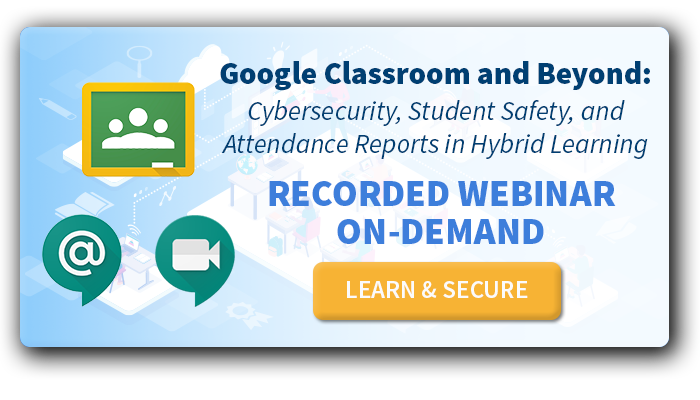Google Classroom monitoring capabilities and limitations for districts working to enable hybrid learning models this school year
According to our recent live poll of K-12 IT leaders, over 60% of school districts are planning on some form of hybrid learning to start off this school year. Many also seem to be planning on using Google Classroom to help enable hybrid or remote learning, based on reports that Google Classroom user numbers have doubled since the beginning of March. This means that it’s likely you’re going to need some form of Google Classroom monitoring and reporting going into the new school year.
With more users, it’s critical to monitor Google Classroom for a number of reasons. You’ll need to monitor student behavior and safety, data loss prevention, and cybersecurity issues to comply with FERPA and CIPA in hybrid learning.
Google Classroom Monitoring—More Than Just Assignments and Grades
Teachers and students use Google Classroom to handle assignments and grades. But, as your district’s G Suite administrator, there are a few things that you may want to keep in mind if your district is planning on using Classroom in the coming school year.
Many schools are weighing options for how much access they want to grant students using Google Classroom this year. They could give students access to allow them to create their own Classrooms and/or post and comment in Classroom threads. That type of communication will help remote learners feel at least some sense of normalcy.
However, there are risks to allowing that type of student access. There have been incidents in the past of students using Google Classroom as another way to post inappropriate language, images, or bully others.
Google Classroom monitoring will be critical to stopping these types of problems if your district opens Classroom to students.
Monitoring Google Classroom Integrations with Drive and Meet
Google Classroom integrates with other apps in the G Suite for Education ecosystem. IT teams can improve operational efficiencies by being to monitor and control data security and student safety policies across all apps.
With the increase in the use of Google Classroom, teachers and students will create more content and will share it in Google Drive. Make sure you can monitor your district’s Google Drive and Shared Drives for issues like cyberbullying and students using Google Docs as a chat room.
You’ll also need to monitor for data security issues to comply with regulations like FERPA. These kinds of documents are less likely to be shared through an app like Classroom, but people make all kinds of silly mistakes! For example, a teacher could accidentally share out a student roster with personal contact information in their Classroom when they meant to share a document meant for an assignment.
Google Classroom also now integrates with Google Meet, so you’re likely to see a significant increase in the number of Meets being hosted. Google Meet provides a Quality Tool that works well for troubleshooting but doesn’t sufficiently address safety and security issues. Monitoring Google Meet for those types of issues is critical and requires new tools to safeguard your students. For example, identifying meeting participants by Organizational Unit to find meetings that didn’t include a teacher or staff is very helpful for admins.
K-12 IT admins are finding that, with the right G Suite for Education security tools and Google Meet best practices, their teachers, students, parents, and administrators are feeling more comfortable with using Google Meet for remote learning. Recommended best practices include simple steps like properly configuring meeting privileges, recordings, and auditing participant behavior.
Limitations in Google Classroom Monitoring
We started digging into the APIs available for Google Classroom shortly after launching our new Google Meet and Chat monitoring capabilities for schools that had to move to remote learning. Unfortunately, what we found is that Google Classroom lacks the robust admin capabilities that other G Suite apps have.
Google created Classroom with teachers and students in mind. Before COVID-19, that didn’t present a problem. But, now that so many schools are planning on using it in the coming school year, we’re going to be running into a lot of administrative roadblocks.
The control provided by Classroom’s Admin Console is quite limited. Though they recently announced new admin features that will improve some administrative issues, there are still some concerning (and surprising) Google Classroom monitoring limitations.
It isn’t possible to detect inappropriate posts and behavior in Classroom comments
This is frustrating to many districts because they would like to enable student comments and chats in Classroom. It encourages greater communication and collaboration, and it keeps all interactions in one place.
Many teachers disable student comments and chats in their Classrooms because without a central system to monitor and control inappropriate behavior, they have yet another task to add to their already burgeoning “to do” lists. Teachers would be solely responsible for manually monitoring, catching, and deleting inappropriate content.
There is a disconnect between Classroom and Meet on the backend
The recent update to Google Classroom that integrates Meet for users is an excellent step forward. However, schools are now in a position where they must confirm that students accessing classrooms remotely are actually attending the sessions. An easy way to do that confirmation would be to run an audit of the students’ Google Meet login and logout behavior tracked against the Classrooms they are supposed to attend.
The problem is that on the back end, these two apps aren’t connected. Admins can audit Meet participation to determine which Google Classrooms a student should attend, but there isn’t any way to connect that information to the Google Meet login/logout activity.
Hopefully, the Classroom product team will recognize this gap and will update it to make reporting on student attendance and engagement a better and easier experience. And not just for teachers and students, but also for administrators who need this kind of visibility and data now more than ever!

![[WEBINAR ON-DEMAND] Monitoring Google Classroom & Beyond. LEARN & SECURE >>](https://no-cache.hubspot.com/cta/default/6834707/abc8b992-1139-4eef-8046-11b3175e8ccf.png)
